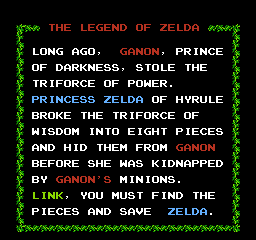| Don't like the ads? Then create an account! Users with accounts have more options than anonymous users. |
The Legend of Zelda (video game)
Alternate versions and re-releases
- 1986 - Original release on the Famicom Disk System (Japan)
- 1987 - Original release on the Nintendo Entertainment System (North America/Europe/Australia)
- 1992 - Re-released on the NES as part of the "Classic Series", featuring a gray cartridge.
- 1994 - Back-ported on a Famicom cartridge and renamed to The Hyrule Fantasy: The Legend of Zelda 1 (Japan)
- 1995/1996 - A remake, titled BS Zelda no Densetsu, was broadcast for the Satellaview add-on of the Super Nintendo in four episodic, weekly installments.
- 2001 - The original game is unlockable in Animal Crossing for the Nintendo GameCube. It is one of the "Forbidden Four," and cannot be accessed in-game without a cheating device.
- 2003 - The original game is one of the four full games on The Legend of Zelda: Collector's Edition
- 2004 - Ported onto the Game Boy Advance as part of the Classic NES Series
- 2006 - Ported as one of the first Virtual Console titles on the Wii
- 2008 - Available as a Masterpiece on Super Smash Bros. Brawl
- 2011/2012 - Ported on select Nintendo 3DS units as an Ambassador Program title, and later became more widely available with a Virtual Console release in 2012 (December 2011 in Japan).
- 2013 - Ported on the Wii U as a downloadable Virtual Console title
- 2014 - Also appears as a Masterpiece on Super Smash Bros. for Wii U
- 2016 - Released as one of the 30 games included on the NES Classic Edition and its Japanese counterpart, Nintendo Classic Mini: Family Computer.
- 2018 - Included as a playable title on the Nintendo Switch Online service. A "special save data" version was released a month later, allowing the player to start the game with more items and Rupees.
Version differences
There are four versions of The Legend of Zelda's original release: the Famicom Disk System, the PRG0 and PRG1 revisions, and the Famicom re-release. The PRG1 revision is the Classic Series re-release[1], and the PRG0 and PRG1 respectively have a product ID of NES-ZL-USA and NES-ZL-USA-1. The Nintendo Entertainment System release features many audio differences from the Famicom Disk System version, to accommodate for the NES's inferior sound channel, and also includes a couple of minor differences from the original.
Starting with 2003, when The Legend of Zelda was included on Collector's Edition, many translation errors were fixed, most notably from the title screen intro. This version was reused in subsequent ports, except for the Virtual Console release on 3DS, which is based on the PRG1 version. The 2003 release's title screen was updated to include 2003 (or 2004 in the Classic NES Series re-release) as a copyright year. In Japan, the Collector's Edition version was released in 2004, and thus the title screen's copyright year was also updated to 2004. This version is based on the Famicom Disk System original instead of the Famicom cartridge re-release, and retains the rewritten intro. Similarly, the Japanese 3DS Virtual Console opted to use the original translation.
There are a couple of other notable differences:
- The Bible was renamed to the Book of Magic from the introduction in international releases. This was done in order to comply with Nintendo of America's censorship policies against adding religious content in-game. The Famicom cartridge re-release also reads "Book of Magic" text but the katakana text still reads Bible.
- In the Famicom Disk System and Famicom versions, one way to defeat a Pols Voice is to yell into the Famicom's built-in microphone. Since the NES hardware does not have this feature, Link can instead defeat a Pols Voice by firing Arrows at it.
- In the NES release, the Zora sprites changed to have a black outline surrounding them, which gives them further on-screen visibility.
- The NES release features the thicker, common font present in many NES games.
- In the PRG1 NES version, the save option screen warns users on how to prevent losing their save data.
- The Famicom Disk System version has a smoother screen transitional effect than the NES and Famicom cartridge releases.
- The PRG1 version of the NES release adds a trademark symbol to the title screen.
- The Famicom cartridge re-release was updated to include the number "1" in its title. This change is also reflected with the title screen.

